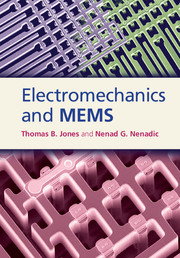Book contents
- Frontmatter
- Contents
- Preface
- 1 Introduction
- 2 Circuit-based modeling
- 3 Capacitive lumped parameter electromechanics
- 4 Small-signal capacitive electromechanical systems
- 5 Capacitive sensing and resonant drive circuits
- 6 Distributed 1-D and 2-D capacitive electromechanical structures
- 7 Practical MEMS devices
- 8 Electromechanics of piezoelectric elements
- 9 Electromechanics of magnetic MEMS devices
- Appendix A Review of quasistatic electromagnetics
- Appendix B Review of mechanical resonators
- Appendix C Micromachining
- Appendix D A brief review of solid mechanics
- Index
- References
2 - Circuit-based modeling
Published online by Cambridge University Press: 05 May 2013
- Frontmatter
- Contents
- Preface
- 1 Introduction
- 2 Circuit-based modeling
- 3 Capacitive lumped parameter electromechanics
- 4 Small-signal capacitive electromechanical systems
- 5 Capacitive sensing and resonant drive circuits
- 6 Distributed 1-D and 2-D capacitive electromechanical structures
- 7 Practical MEMS devices
- 8 Electromechanics of piezoelectric elements
- 9 Electromechanics of magnetic MEMS devices
- Appendix A Review of quasistatic electromagnetics
- Appendix B Review of mechanical resonators
- Appendix C Micromachining
- Appendix D A brief review of solid mechanics
- Index
- References
Summary
Fundamentals of circuit theory
This chapter summarizes basic circuit theory concepts, shows how to model capacitive MEMS actuator structures as simple circuit devices, and introduces elements of multiport network theory for later use in modeling electromechanical systems. The approach is a very practical one, based on reasonable approximations and easy-to-use inspection methodologies. Students seeking more background on the theoretical underpinnings of circuit modeling should refer to Appendix A, which summarizes the electroquasistatic and magnetoquasistatic approximations, reveals the origins of the models for capacitors and inductors, and relates them to basic circuit theory.
Our emphasis on circuit-based representations for MEMS devices is motivated by the fact that they can be embedded directly into the electronic system models for the control and sensing circuitry. With this groundwork, we will later investigate conventional implementations of capacitive sensors and actuators, including inverting operational-amplifier circuits, two-plate and three-plate topologies, and the half-bridge differential scheme. For sufficiently complex systems, software tools such as PSPICE or CADENCE might be used, but in this text on fundamentals, we restrict the focus to systems that can be treated analytically.
- Type
- Chapter
- Information
- Electromechanics and MEMS , pp. 10 - 43Publisher: Cambridge University PressPrint publication year: 2013



